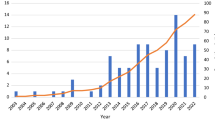Abstract
Debris flows caused serious loss of human lives and damages to properties in Taiwan for the past decades. A number of methods for prediction of debris flows have been studied including numerical method, statistic method, experiment method and neural network method in recent years. This study proposed a genetic algorithm (GA) model for occurrence prediction of debris flows. A total of 154 potential cases of debris flows collected in eastern Taiwan were fed into the GA for training and testing. The average ratio of successful prediction reaching 90.4% demonstrates that the presented GA model can provide a stable and reliable result for prediction of debris flows in the hazard mitigation and guarding system.




Similar content being viewed by others
References
Chan L, Huang M (1987) A study of the artificial intelligence system for debris flow warning system. In: The Proceedings of 10th Hydraulic Engineering Conference, Taipei, Taiwan, ROC, H2–H7
Chang TC, Ru-Jen C (2006) Application of back-propagation networks in debris flows. Eng Geol 85:270–280
Chang FJ, Lee SP (1997) A study of the intelligent control theory for the debris flow warning system. In: Proceedings of the 1st debris flows conference, Taipei, Taiwan, ROC, pp 109–123
Chang TC (1995) Study of model for hydrograph of debris flows. The proceedings of 10th National Conference of Technology and Vocational Education, Industry (V), pp 265–272
Chang TC, Hsieh CL (1996) Site investigation and analysis for debris flows in eastern Lan-Yun District. Chin Water Soil Reserv Rep Taiwan 27(2):139–150
Chang TC, Hsieh CL (1997) Field investigation and analysis of debris flow in central Taiwan. J Chin Agric Eng Taiwan ROC 43(3):31–46
Chang TC (1998) Field investigation and analysis of potential debris flow in northern Taiwan. J Chin Agric Eng Taiwan ROC 44(3):51–63
Chen SH (1984) Study of investigation method for debris flow hazard. The Department of Forest, National Taiwan University, pp 99–101
Chyan-Deng J et al (2004) A debris-flow rainfall-based warning model. J Chin Soil Water Conserv 35(3):275–285
Fang CC, Wu MF, Pon GC (1999) Study in critical precipitation line of debris flows in Fongchui. Geotech Technol Taiwan 74:39–46
Fang CC, Yao CS (1997) Preliminary study of hydrology and geology conditions in occurring region of debris flows in eastern Taiwan. The 1997 Agricultural Engineering Conference, Taiwan, ROC, pp 521–531
Fan JC, Tsai IT (2003) Real-time evaluation and test for the occurrence probability of debris flows of the first order streams in the Nan-Tou Area, Thesis of master at Taiwan University
Fogel DB (ed) (1998) Evolutionary computation, IEEE Press, New York
Goldenberg DE (1989) Genetic algorithms in search, optimization and machine learning, Addison Wesley, Reading
Hirano M, Moriyama T (1993) Prediction of occurrence and runoff analysis of debris flows. In: Proceedings of National Conference on Hydraulic Engineering, ASCE, pp 1780–1785
Hsieh CL (1993) Debris flow warning system II, Project of Council of Agriculture, Executive Yuan, Republic of China
Hsieh CL, Lu YC, You BS, Chen LR (1995) Methodology for critical precipitation line of debris flows occurrence. Chin Water Soil Reserv Rep Taiwan ROC 26(3):167–172
Ivakhnenko AG (1970) Heuristic self-organization in problem of engineering cybernetics. Automatica 6:207–219
Johnson AM, Rodine JR (1984) Debris flow. In: Brunsden D, Prior DB (eds) Slope instability. Wiley, New York
Keefer DK, Wilson RC, Mark RK, Brabb EE, Brown WM, Ellen SD, Harp EL, Wieczorek GF, Alger CS, Zatkin RS (1987) Real-time landslide warning during heavy rainfall. Science 238:921–925
Lee SP, Chang FJ (1995) A study of fuzzy control theorem for debris flows warning system. J Chin Soil Water Conserv 26(2):145–154
Lin ML, Jeng FS (2000) Characteristics of hazard induced by extremely heavy rainfall in central Taiwan–Typhoon herb. Eng Geol 58(2):191–207
Michalewicz Z (1999) Genetic algorithms + data structures = evolution programs, Springer, Berlin
Negnevitsky M (2002) Artificial intelligence: a guide to intelligent systems. Addison Wesley, Harlow
Rumelhart DE, Hinton GE, William RJ (1986) Learning representations by back-propagation errors. Nature (Lond) 323:533–536
Russell S, Norvig P (2003) Artificial intelligence—a modern approach, 2nd edn. Prentice Hall, Englewood Cliffs
Schalkoff RJ (1997) Artificial neural networks. International Editions, McGraw-Hill, New York
Senoo K et al (1985) Rainfall indexes for debris flow warning evacuating program. Shin-Sabo 38(2):16–21
Takahashi T (1977) A mechanism of occurrence of mud-debris flows and their characteristics in motion. Ann Disaster Prey Res Inst Kyoto Univ V20B-2:405–435
Wang DS (1994) Study of mechanism of debris flow occurrence, Thesis in Department of Civil Engineering, National Taiwan University
Wieczorek GF (1987) Effect of rainfall intensity and duration on debris flows in central Santa Cruz Mountains, California, 9 flows/avalanches: Process, Recognition and Mitigation, Geological Society of America. Rev Eng Geol 7:93–104
Author information
Authors and Affiliations
Corresponding author
Rights and permissions
About this article
Cite this article
Chang, TC., Chien, YH. The application of genetic algorithm in debris flows prediction. Environ Geol 53, 339–347 (2007). https://doi.org/10.1007/s00254-007-0649-2
Received:
Accepted:
Published:
Issue Date:
DOI: https://doi.org/10.1007/s00254-007-0649-2




